Page 292 of 509
291 Controls in detail
Useful features
Ashtrays
Center console ashtray
1Cover plate
2Remove insert
3Ashtray
�Opening: Press cover plate1 forward
until it engaged.
�Removing the insert: Grab the insert
on the grooved side and pull it up and
out in the direction indicated by the
arrow2.
�Reinstalling ashtray insert: Install
the insert by pushing it back into the
frame until it engages.
�Closing: Tap the front of the cover
plate1.
The cover will retract and the ashtray
will close.
Warning!G
Remove ashtray only with vehicle standing
still. Depress the parking brake to secure
vehicle from movement.
Move gear selector lever to positionP (man-
ual transmission: second gear). With the au-
tomatic transmission* set toP (manual
transmission: second gear), turn off the
engine.
Page 305 of 509
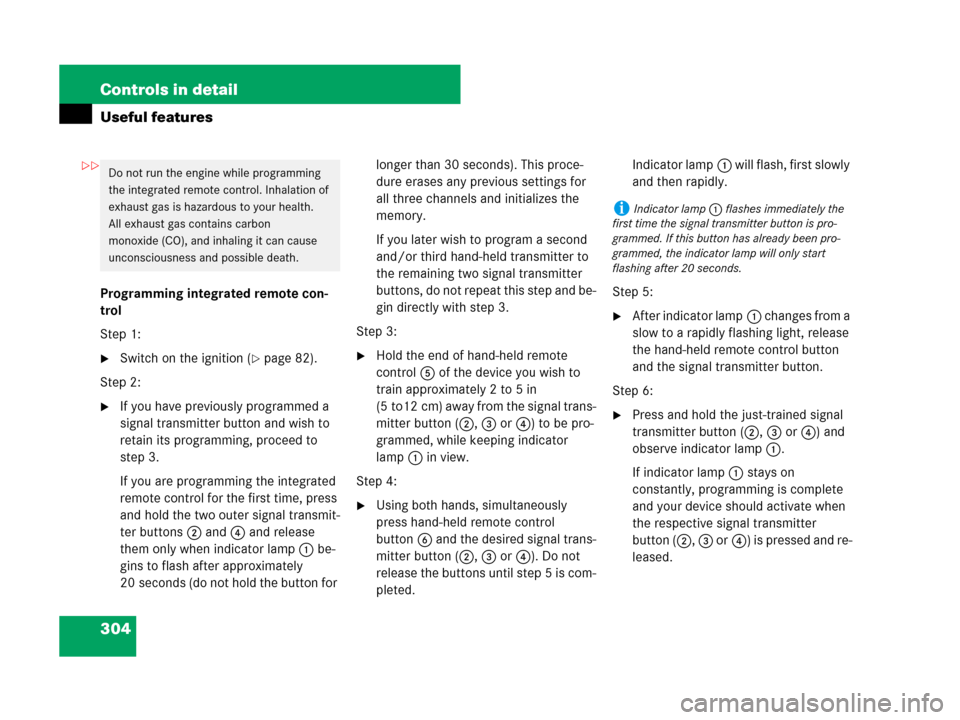
304 Controls in detail
Useful features
Programming integrated remote con-
trol
Step 1:
�Switch on the ignition (�page 82).
Step 2:
�If you have previously programmed a
signal transmitter button and wish to
retain its programming, proceed to
step 3.
If you are programming the integrated
remote control for the first time, press
and hold the two outer signal transmit-
ter buttons2 and4 and release
them only when indicator lamp1 be-
gins to flash after approximately
20 seconds (do not hold the button for longer than 30 seconds). This proce-
dure erases any previous settings for
all three channels and initializes the
memory.
If you later wish to program a second
and/or third hand-held transmitter to
the remaining two signal transmitter
buttons, do not repeat this step and be-
gin directly with step 3.
Step 3:
�Hold the end of hand-held remote
control5 of the device you wish to
train approximately 2 to 5 in
(5 to12 cm) away from the signal trans-
mitter button (2, 3 or4) to be pro-
grammed, while keeping indicator
lamp1 in view.
Step 4:
�Using both hands, simultaneously
press hand-held remote control
button6 and the desired signal trans-
mitter button (2, 3 or4). Do not
release the buttons until step 5 is com-
pleted.Indicator lamp1 will flash, first slowly
and then rapidly.
Step 5:
�After indicator lamp1 changes from a
slow to a rapidly flashing light, release
the hand-held remote control button
and the signal transmitter button.
Step 6:
�Press and hold the just-trained signal
transmitter button (2, 3 or4) and
observe indicator lamp1.
If indicator lamp1 stays on
constantly, programming is complete
and your device should activate when
the respective signal transmitter
button (2, 3 or4) is pressed and re-
leased.
Do not run the engine while programming
the integrated remote control. Inhalation of
exhaust gas is hazardous to your health.
All exhaust gas contains carbon
monoxide (CO), and inhaling it can cause
unconsciousness and possible death.
iIndicator lamp1 flashes immediately the
first time the signal transmitter button is pro-
grammed. If this button has already been pro-
grammed, the indicator lamp will only start
flashing after 20 seconds.
��
Page 310 of 509
309 Operation
The first 1000 miles (1500 km)
Driving instructions
At the gas station
Engine compartment
Tires and wheels
Winter driving
Maintenance
Vehicle care
Page 311 of 509

310 Operation
In the “Operation” section you will find de-
tailed information on operating, maintain-
ing and caring for your vehicle.
The first 1000 miles (1500 km)
The more cautiously you treat your vehicle
during the break-in period, the more satis-
fied you will be with its performance later
on.
�Drive your vehicle during the first
1 000 miles (1 500 km) at varying but
moderate vehicle and engine speeds.
�During this period, avoid heavy loads
(full throttle driving) and excessive en-
gine speeds (no more than
2/3 of maxi-
mum rpm in each gear).
�Avoid accelerating by kick-down.
�Do not attempt to slow the vehicle
down by shifting to a lower gear using
the gear selector lever.
�Select gear ranges3,2or1 only when
driving at moderate speeds (for hill
driving).
�Select C as the preferred shift program
(
�page 144) for the first 1 000 miles
(1 500 km).After 1 000 miles (1 500 km) you may grad-
ually increase vehicle and engine speeds
to the permissible maximum.
All of the above instructions, as may apply
to your vehicle type, also apply when driv-
ing the first 1 000 miles (1 500 km) after
the engine or the rear differential has been
replaced.
iAlways obey applicable speed limits.
Page 312 of 509
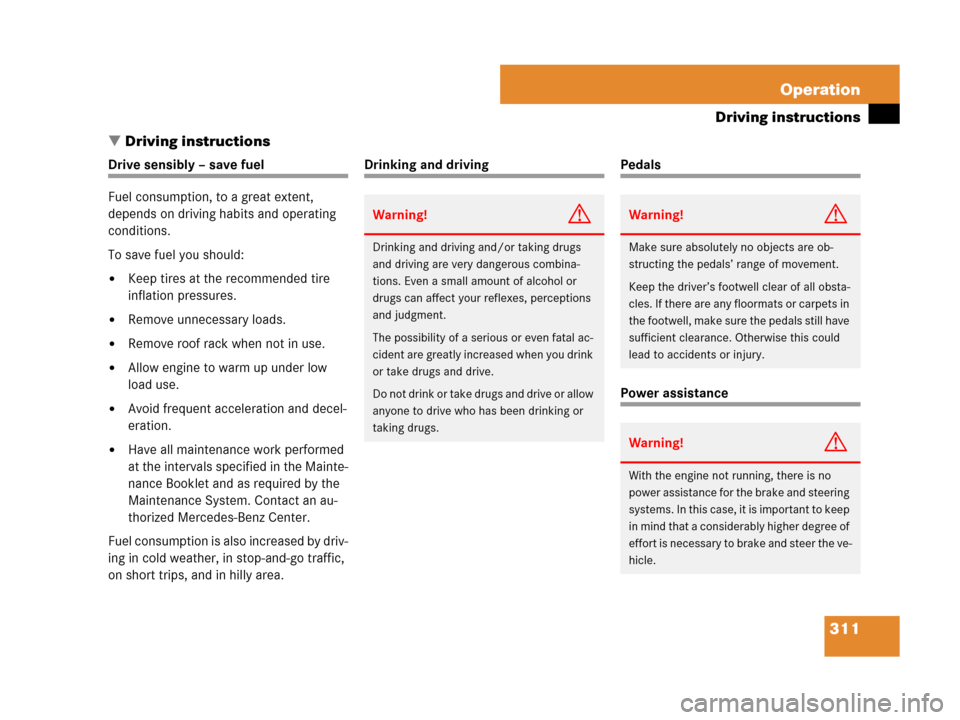
311 Operation
Driving instructions
�Driving instructions
Drive sensibly – save fuel
Fuel consumption, to a great extent,
depends on driving habits and operating
conditions.
To save fuel you should:
�Keep tires at the recommended tire
inflation pressures.
�Remove unnecessary loads.
�Remove roof rack when not in use.
�Allow engine to warm up under low
load use.
�Avoid frequent acceleration and decel-
eration.
�Have all maintenance work performed
at the intervals specified in the Mainte-
nance Booklet and as required by the
Maintenance System. Contact an au-
thorized Mercedes-Benz Center.
Fuel consumption is also increased by driv-
ing in cold weather, in stop-and-go traffic,
on short trips, and in hilly area.
Drinking and drivingPedals
Power assistance
Warning!G
Drinking and driving and/or taking drugs
and driving are very dangerous combina-
tions. Even a small amount of alcohol or
drugs can affect your reflexes, perceptions
and judgment.
The possibility of a serious or even fatal ac-
cident are greatly increased when you drink
or take drugs and drive.
Do not drink or take drugs and drive or allow
anyone to drive who has been drinking or
taking drugs.
Warning!G
Make sure absolutely no objects are ob-
structing the pedals’ range of movement.
Keep the driver’s footwell clear of all obsta-
cles. If there are any floormats or carpets in
the footwell, make sure the pedals still have
sufficient clearance. Otherwise this could
lead to accidents or injury.
Warning!G
With the engine not running, there is no
power assistance for the brake and steering
systems. In this case, it is important to keep
in mind that a considerably higher degree of
effort is necessary to brake and steer the ve-
hicle.
Page 313 of 509
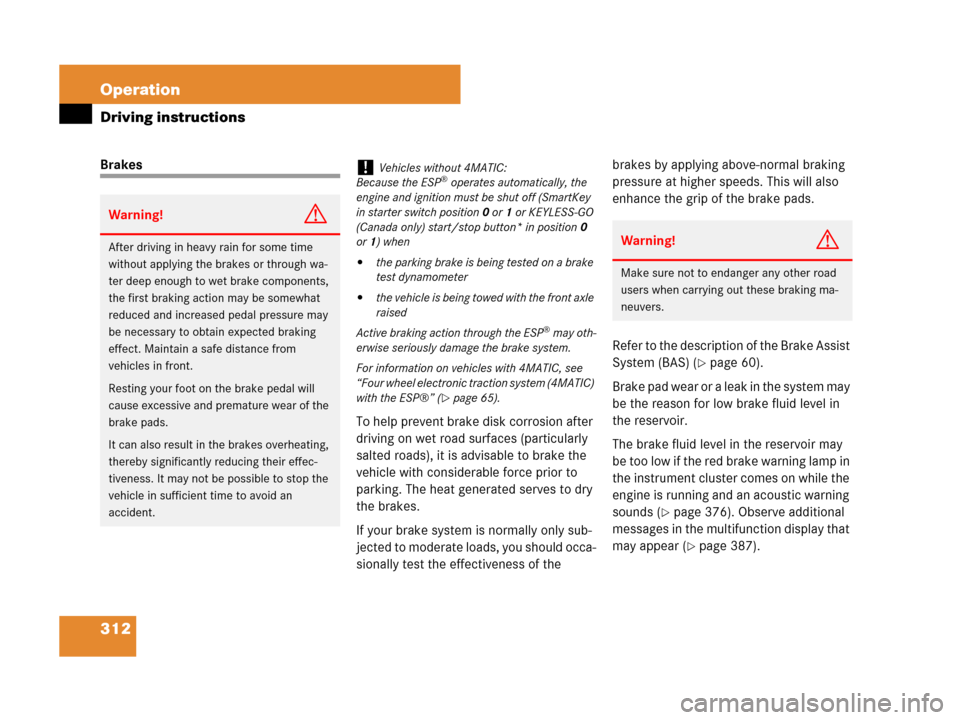
312 Operation
Driving instructions
Brakes
To help prevent brake disk corrosion after
driving on wet road surfaces (particularly
salted roads), it is advisable to brake the
vehicle with considerable force prior to
parking. The heat generated serves to dry
the brakes.
If your brake system is normally only sub-
jected to moderate loads, you should occa-
sionally test the effectiveness of the brakes by applying above-normal braking
pressure at higher speeds. This will also
enhance the grip of the brake pads.
Refer to the description of the Brake Assist
System (BAS) (
�page 60).
Brake pad wear or a leak in the system may
be the reason for low brake fluid level in
the reservoir.
The brake fluid level in the reservoir may
be too low if the red brake warning lamp in
the instrument cluster comes on while the
engine is running and an acoustic warning
sounds (
�page 376). Observe additional
messages in the multifunction display that
may appear (
�page 387).
Warning!G
After driving in heavy rain for some time
without applying the brakes or through wa-
ter deep enough to wet brake components,
the first braking action may be somewhat
reduced and increased pedal pressure may
be necessary to obtain expected braking
effect. Maintain a safe distance from
vehicles in front.
Resting your foot on the brake pedal will
cause excessive and premature wear of the
brake pads.
It can also result in the brakes overheating,
thereby significantly reducing their effec-
tiveness. It may not be possible to stop the
vehicle in sufficient time to avoid an
accident.
!Vehicles without 4MATIC:
Because the ESP® operates automatically, the
engine and ignition must be shut off (SmartKey
in starter switch position0 or1 or KEYLESS-GO
(Canada only) start/stop button* in position0
or1) when
�the parking brake is being tested on a brake
test dynamometer
�the vehicle is being towed with the front axle
raised
Active braking action through the ESP
® may oth-
erwise seriously damage the brake system.
For information on vehicles with 4MATIC, see
“Four wheel electronic traction system (4MATIC)
with the ESP®” (
�page 65).
Warning!G
Make sure not to endanger any other road
users when carrying out these braking ma-
neuvers.
Page 314 of 509
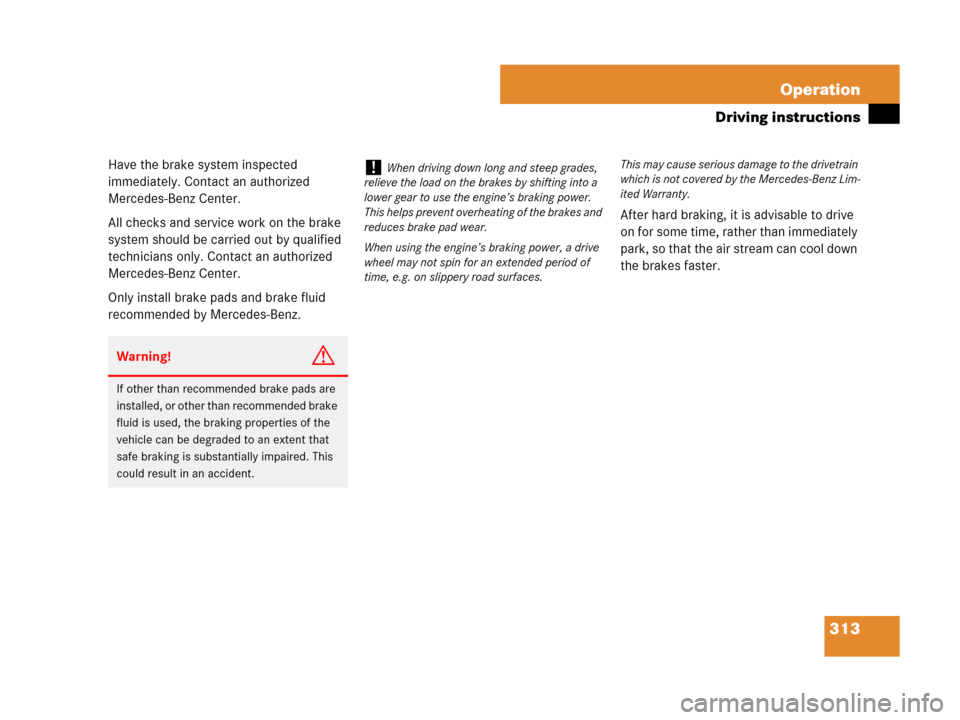
313 Operation
Driving instructions
Have the brake system inspected
immediately. Contact an authorized
Mercedes-Benz Center.
All checks and service work on the brake
system should be carried out by qualified
technicians only. Contact an authorized
Mercedes-Benz Center.
Only install brake pads and brake fluid
recommended by Mercedes-Benz.After hard braking, it is advisable to drive
on for some time, rather than immediately
park, so that the air stream can cool down
the brakes faster.
Warning!G
If other than recommended brake pads are
installed, or other than recommended brake
fluid is used, the braking properties of the
vehicle can be degraded to an extent that
safe braking is substantially impaired. This
could result in an accident.
!When driving down long and steep grades,
relieve the load on the brakes by shifting into a
lower gear to use the engine’s braking power.
This helps prevent overheating of the brakes and
reduces brake pad wear.
When using the engine’s braking power, a drive
wheel may not spin for an extended period of
time, e.g. on slippery road surfaces.This may cause serious damage to the drivetrain
which is not covered by the Mercedes-Benz Lim-
ited Warranty.
Page 315 of 509
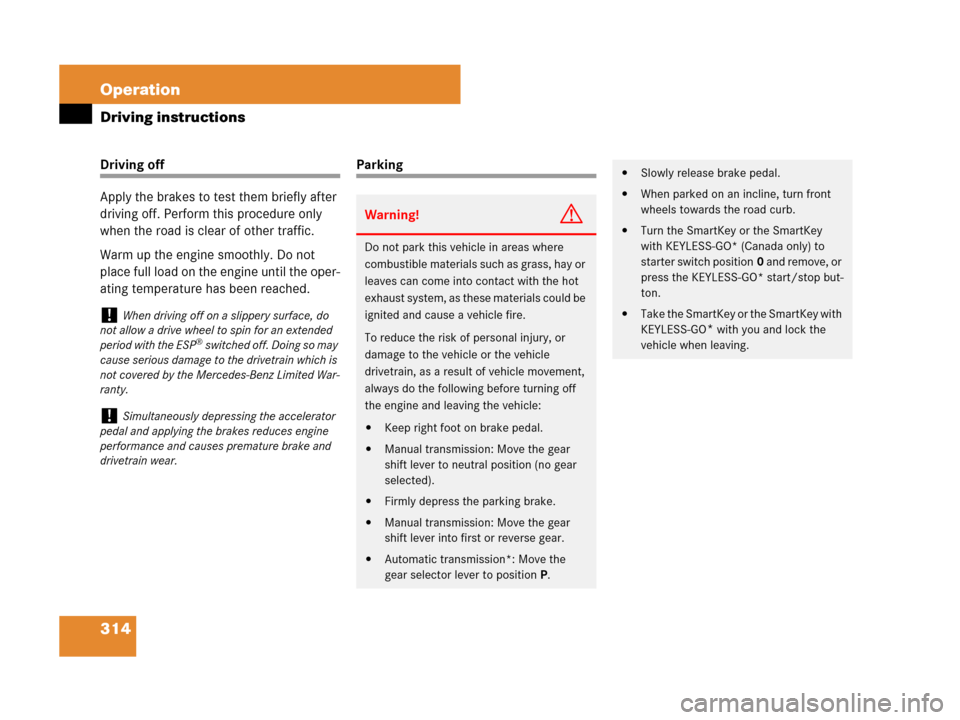
314 Operation
Driving instructions
Driving off
Apply the brakes to test them briefly after
driving off. Perform this procedure only
when the road is clear of other traffic.
Warm up the engine smoothly. Do not
place full load on the engine until the oper-
ating temperature has been reached.Parking
!When driving off on a slippery surface, do
not allow a drive wheel to spin for an extended
period with the ESP
® switched off. Doing so may
cause serious damage to the drivetrain which is
not covered by the Mercedes-Benz Limited War-
ranty.
!Simultaneously depressing the accelerator
pedal and applying the brakes reduces engine
performance and causes premature brake and
drivetrain wear.
Warning!G
Do not park this vehicle in areas where
combustible materials such as grass, hay or
leaves can come into contact with the hot
exhaust system, as these materials could be
ignited and cause a vehicle fire.
To reduce the risk of personal injury, or
damage to the vehicle or the vehicle
drivetrain, as a result of vehicle movement,
always do the following before turning off
the engine and leaving the vehicle:
�Keep right foot on brake pedal.
�Manual transmission: Move the gear
shift lever to neutral position (no gear
selected).
�Firmly depress the parking brake.
�Manual transmission: Move the gear
shift lever into first or reverse gear.
�Automatic transmission*: Move the
gear selector lever to positionP.
�Slowly release brake pedal.
�When parked on an incline, turn front
wheels towards the road curb.
�Turn the SmartKey or the SmartKey
with KEYLESS-GO* (Canada only) to
starter switch position0 and remove, or
press the KEYLESS-GO* start/stop but-
ton.
�Take the SmartKey or the SmartKey with
KEYLESS-GO
* with you and lock the
vehicle when leaving.